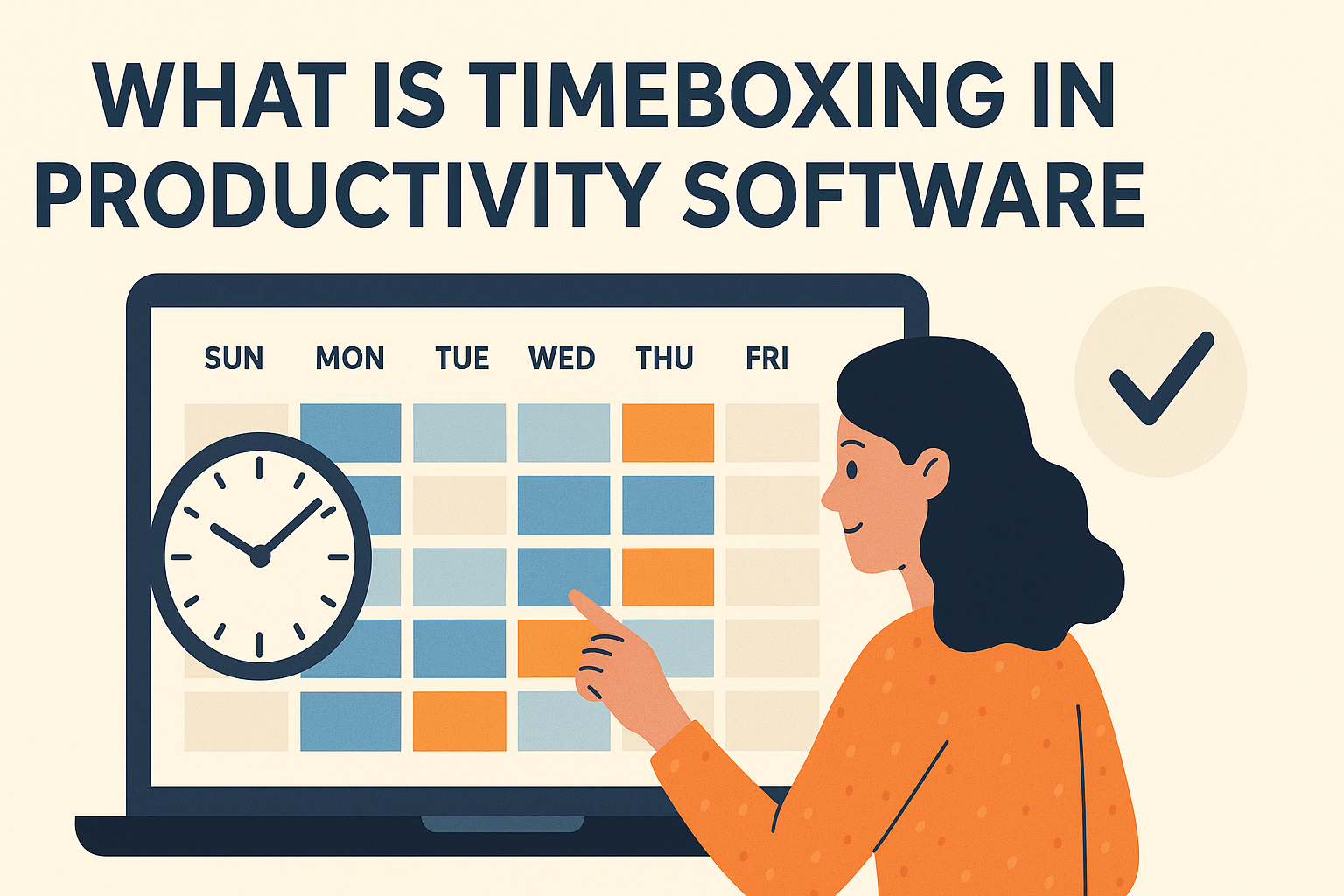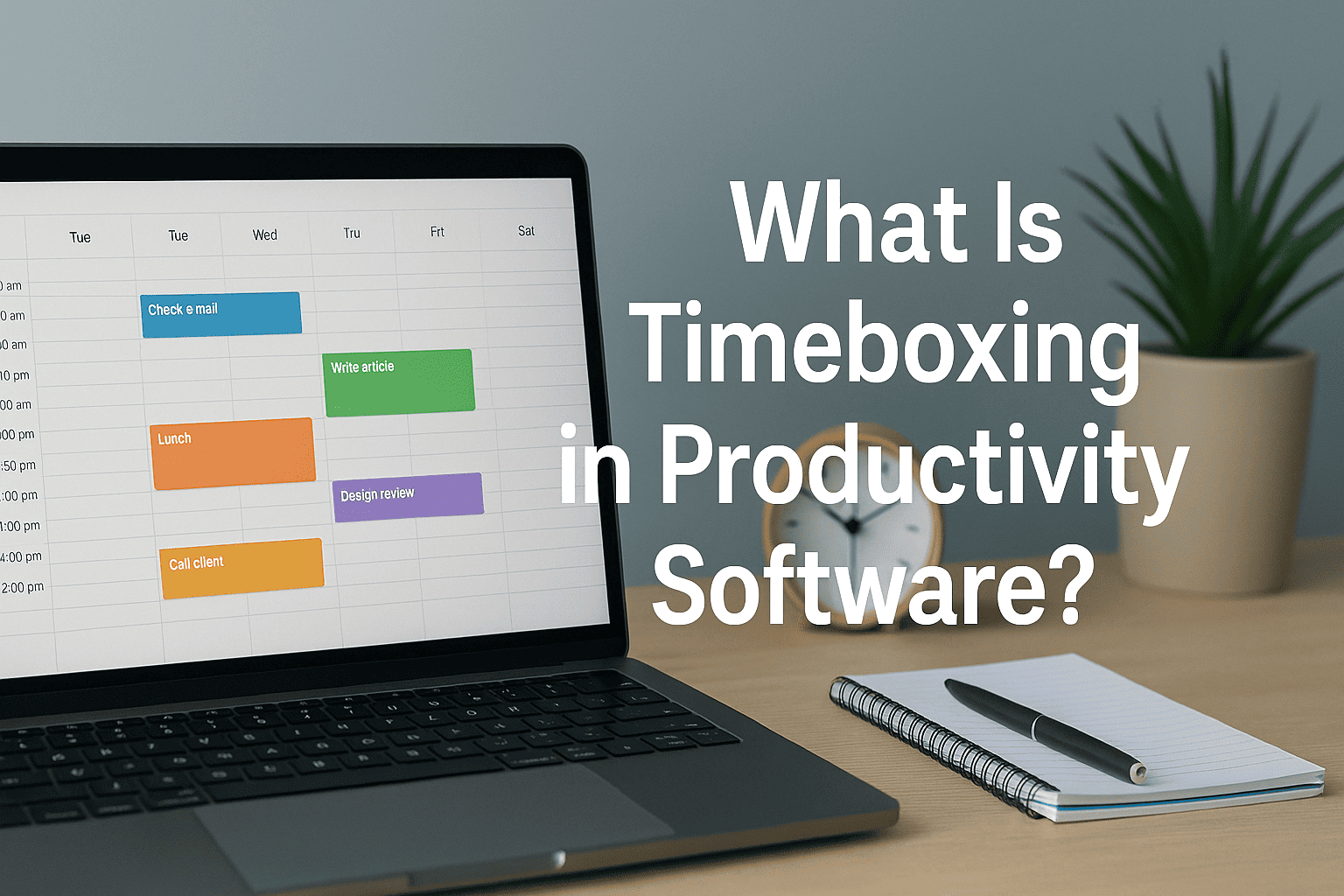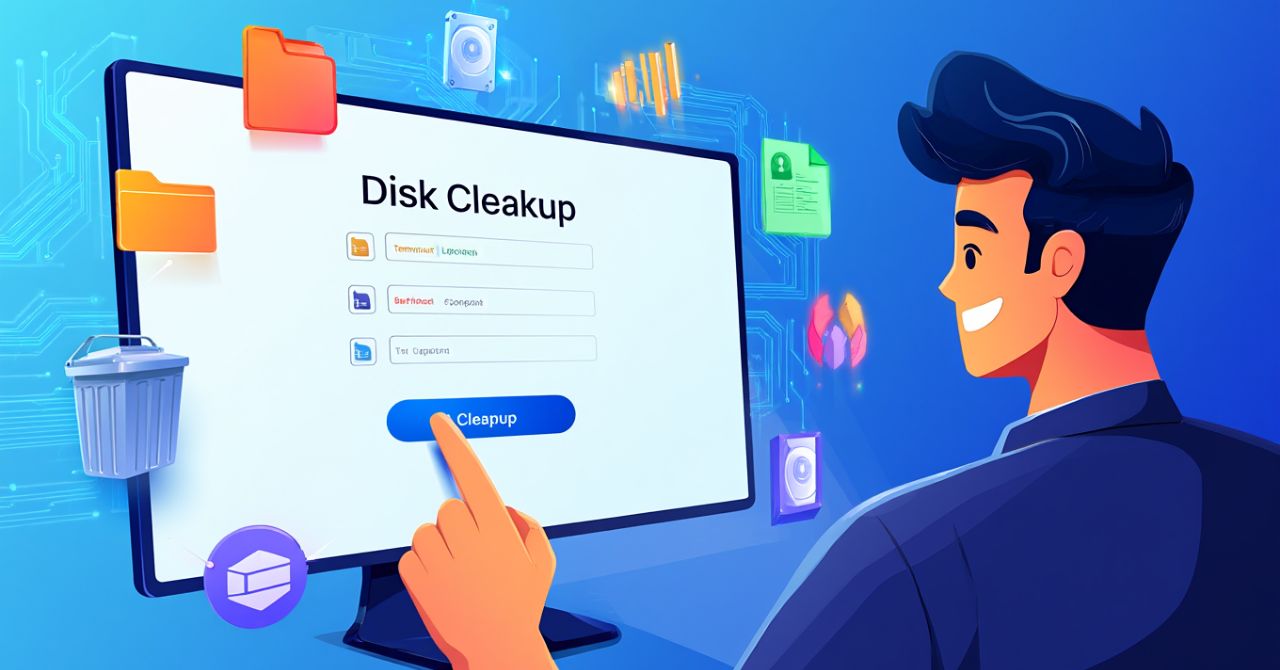A few years ago, I used to start every day with a long, color-coded to-do list – and end it feeling like I barely got anything done. Sound familiar? That was before I discovered what timeboxing in productivity software really meant.
Once I began assigning fixed time blocks to each task – and actually sticking to them – my days became less chaotic and more intentional. Suddenly, I was writing reports in 90 minutes instead of 3 hours, and meetings no longer hijacked my calendar. It wasn’t magic – it was timeboxing, built right into the apps I already used.
So, what is timeboxing in productivity software, and why is it such a game-changer for anyone who feels constantly “busy but behind”? Let’s dive into the method, the tools, and how you can start applying it today to take back control of your time.
1. What Is Timeboxing in Productivity Software?
Timeboxing is a technique where you assign a fixed, predefined block of time to a specific task—and commit to stopping once the time is up, regardless of whether the task is complete.

This approach shifts your mindset from “work until it’s done” to “work until the timer ends.”
For example:
-
Instead of saying “I’ll write this report today,” you say “I’ll spend 90 minutes writing this report from 10:00 to 11:30.”
It’s a simple concept, but when applied consistently, it can transform the way you work.
2. Why Is Timeboxing Popular in Productivity Software?
In traditional planning, tasks can sprawl and consume more time than intended. Timeboxing forces you to define the scope and deadline upfront, which is exactly what many productivity apps are designed to help with.
Here’s why productivity software and timeboxing work well together:
-
Digital calendars and planners make scheduling timeboxes easy.
-
Timers and alerts help enforce the time limit.
-
Apps can integrate tasks directly into your daily schedule for accountability.
3. Timeboxing vs Time Blocking: What’s the Difference?

Although often confused, timeboxing and time blocking are two distinct approaches:
| Aspect | Timeboxing | Time Blocking |
|---|---|---|
| Purpose | Set limits on how long to work on a task | Reserve a time slot to work on a task |
| Flexibility | Task ends when time ends | Task may extend past the time block |
| Focus | Completion is secondary to focus during the period | Often aims to finish the task within the block |
In essence, time blocking plans when you’ll do something, while timeboxing sets a strict limit on how long you’ll spend doing it.
4. Key Benefits of Using Timeboxing in Productivity Tools
When combined with digital tools, timeboxing unlocks several powerful benefits:
4.1. Forces Prioritization
You’re allocating time, not just listing tasks—so you must decide what truly deserves your attention.
4.2. Reduces Perfectionism
When you know the clock is ticking, you’re more likely to focus on completing rather than over-refining.
4.3. Improves Focus and Flow
Time limits create urgency, which can push you into a deep, distraction-free flow state.
4.4. Makes Time Visible
Seeing tasks plotted on your calendar helps you visualize workload and prevents overcommitment.
4.5. Builds Momentum
Finishing focused timeboxes—even without completing a task—creates a sense of progress.
5. How Timeboxing Works in Popular Productivity Software
Many digital tools now include features that make timeboxing easy to implement. Here are examples of how modern software supports this method:
5.1. Calendar-Based Apps (e.g. Google Calendar, Outlook)
-
Create events named after your tasks (e.g. “Write blog post – 10:00–11:00”).
-
Color-code tasks based on type or priority.
-
Use alerts to stay on track.
5.2. Task Managers with Scheduling Features (e.g. Todoist + Calendar, ClickUp, Sunsama)
-
Drag tasks onto your daily timeline.
-
Assign estimated durations.
-
View upcoming timeboxes alongside deadlines.
5.3. Time Tracking + Pomodoro Tools (e.g. Toggl, TickTick, Focus To-Do)
-
Set a timer for each task or timebox.
-
Track how much time you actually spent.
-
Use session data to improve estimates over time.
5.4. AI-Powered Schedulers (e.g. Motion, Reclaim.ai)
-
Automatically fit tasks into your calendar based on urgency and availability.
-
Adapt in real-time when meetings or interruptions occur.
6. How to Start Using Timeboxing Effectively
If you’re new to timeboxing, here’s a step-by-step process you can follow using your favorite productivity software:
6.1. Step 1: Identify Top Priorities
At the start of your day, pick 3–5 tasks you truly want to make progress on.
6.2. Step 2: Estimate Time Honestly
Be realistic. Most tasks take longer than expected—add buffer time if needed.
6.3. Step 3: Schedule Timeboxes
Plot time on your calendar or tool of choice. Treat these like real meetings—non-negotiable.
6.4. Step 4: Set a Timer and Begin
During the timebox, commit fully. Turn off notifications and avoid multitasking.
6.5. Step 5: Stop When Time Ends
Even if the task isn’t done, stop. Reflect and decide whether to schedule another timebox later.
Read more: What is BIOS? Everything You Need to Know
7. Timeboxing for Teams and Agile Workflows
Timeboxing isn’t just for individuals. In agile software development, it’s a core principle used in:
-
Sprints: Fixed two-week time periods for teams to deliver features.
-
Standups: 15-minute capped check-ins.
-
Retrospectives: Time-limited review sessions.
Project management platforms like Jira, Trello, and Asana support timeboxed workflows, helping teams stay aligned and productive.
8. Who Benefits Most from Timeboxing?
Timeboxing is especially valuable for:
-
Freelancers: To track billable hours and stay focused on deliverables.
-
Students: To break down study sessions and avoid burnout.
-
Remote workers: To combat procrastination and maintain structure.
-
Managers: To reduce meeting creep and protect focus time.
-
Creative professionals: To set limits on open-ended tasks like writing or design.
9. Common Mistakes to Avoid
Like any productivity method, timeboxing has its pitfalls. Avoid these common errors:
-
Overstuffing your calendar with back-to-back timeboxes
-
Underestimating how long tasks really take
-
Ignoring breaks and recovery time
-
Treating timeboxing as rigid and inflexible (it should evolve)
10. FAQs About Timeboxing in Productivity Software
10.1. Can I use timeboxing without software?
Yes—pen and paper work too. But software makes it easier to adjust, repeat, and track progress over time.
10.2. Is timeboxing only useful for work tasks?
No. It works great for personal routines, fitness, learning, and even relaxation—anything that benefits from structure.
10.3. How is timeboxing different from Pomodoro?
Pomodoro uses fixed 25-minute intervals with short breaks, while timeboxing is more flexible – you define the duration and structure.
11. Conclusion
What is timeboxing in productivity software?
It’s a method that brings structure, intention, and time-awareness to your digital workflow. By allocating fixed time blocks to tasks—and sticking to them—you make better use of your time, avoid mental fatigue, and improve overall output.
Whether you’re using a simple calendar or advanced AI scheduler, timeboxing can dramatically shift the way you work.
Ready to take control of your time? Explore more techniques like this in our Software section at Softbuzz and unlock new levels of productivity.










